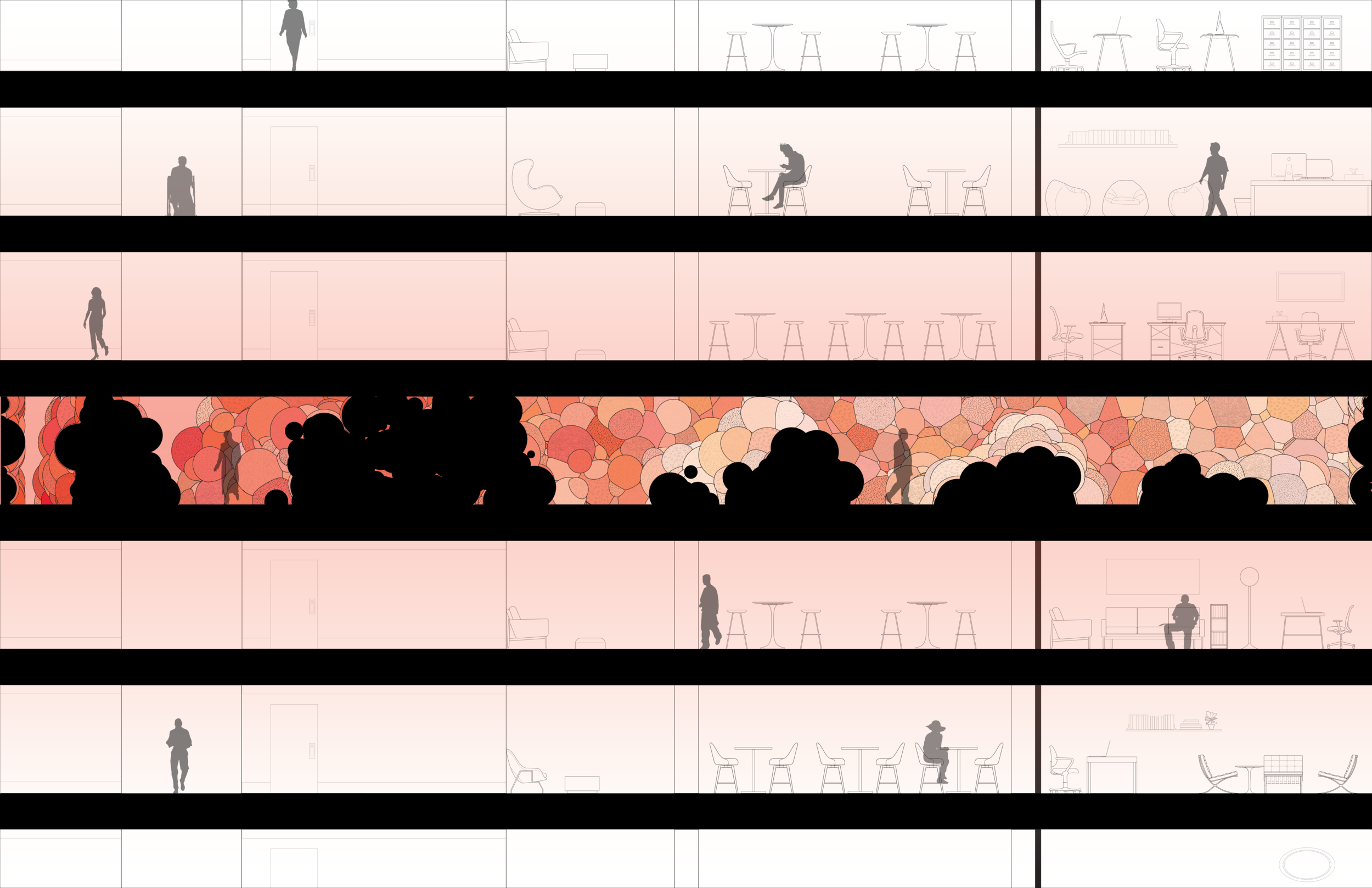
Office Climates
Hyper-synthetic imitations of natural environments serve as time capsules in a work-obsessed, climate change-affected future.
Spring 2019
Office Climates articulates an architectural future in which most New Yorkers have no access to the vibrant environmental features of the past. In a version of capitalist society accelerated to its natural end, where work-play spaces have mutated to mirror the experiences of nature in a hyper-synthetic fashion, Manhattan’s X Building (1251 Avenue of the Americas) skyscraper contains a series of “natural” settings for relaxation interspersed throughout the mundanity of everyday corporate reality. As the natural world outside has eroded away due to climate change and a dramatic scale of never-ending urbanization, the imagined corporation inhabiting the X Building has constructed climates en miniature within their walls, supposed places to experience the benefits of nature, distilled and cheapened to their most synthetic essence.
You had once been told-
perhaps by a grandmother, or perhaps as happenstance,
a snippet of the schoolyard mythos which circulates between children-
that the earth was once mother to a homegrown architecture:
the sinewy stretches of a crawling vine,
the rows of great trees like gargantuan foot soldiers, engaged
in a perpetual inter-calvary waltz
behind enemy lines, great icey monuments
to the strange persistence of the earth against
the better efforts of mankind, until,
of course, it could persist no longer.
You ponder these fairy tales of an ancient earth.
Tendrils of past realities brush against your ankles,
encroaching forward through time into the domain of present,
the domain of the synthetic, the domain of approximation.
You ponder how easily the earth bent to human will.
You wonder what was lost.
You feel the volume beneath your feet,
the clean white ice resonating at the
frequency only something massive can hold,
here at the throat of the world.
You feel a crack, a catch
at the base of your neck and an echo
swallowed up in the scope of that which is immutable.
This was ice. This was the cool thrumming engine
from which the earth sustained herself. This was
ground zero, a symptom rather than a cause,
but still the first domino in a cascade
which would become a whirlpool
which would become cataclysmic.
You walk on to a place where the ice is an embrace,
holding you close beneath a white mask
that coats each cliffside. Of course, the cushion
of ice gave way to jagged contours, and the mountains
cried out in shame, bashful with their craggy backs
exposed. Their powder-white makeup dripped down
their necks, Kabuki actors in a nuclear meltdown.
The sea was not always a dull and listless sheet
across the domain unfortunate enough not to be earth.
You sense an Atlantian labyrinth below the
surface: sediment mountains, aggregate skeletons
of forgotten grotto cities. Here are the friends
of the tiny sea sprites who make their homes
in the crannies of washed-out technicolor bone spurs.
You wander through sediment cities, all
glowing and simmering down here in the gloom.
The forest breathes. You swing through the
canopy, above and among and within, floating
from branch to branch, dodging the great trunks
as their heavy heads crash down onto the floor
beneath you and their bodies are carved up
on a thanksgiving dais and dragged away.
It’s a long way to float between branches now,
and the forest can only hold off
the guardian angels of gravity for so long.
You are dancing a strange, rigid waltz with giants
who hold out their arms to you, let you ride along
through each slow step atop their shoes, allow you
one careful caress of their tawny skin
while they whisper ancient secrets through the low,
resounding hum that lives deep in their wooden spines.
These are, of course, nothing more than
dioramas; a historical theme park in carefully measured
abstractions of our failures to save the original mother
of our architecture. These are dollhouses, five of millions:
places for the modern man to unpack a lunch, drop off his child
to play, draft an email among the artifacts of what
he might imagine those earlier denizens of earth experienced
as environmental harmony. These are the scraps of our negligence,
a mausoleum to inhabit and enjoy, a place where we imagine
we can remember.
It’s a lie, of course: we are alien astronomers, speculating
as to experiences we did not inherit; laying claim to those biomes
our ancestors spat on and gutted for their bones.
But, of course, it is all we have:
is it such a crime to remember? Is it such a crime
to try?



